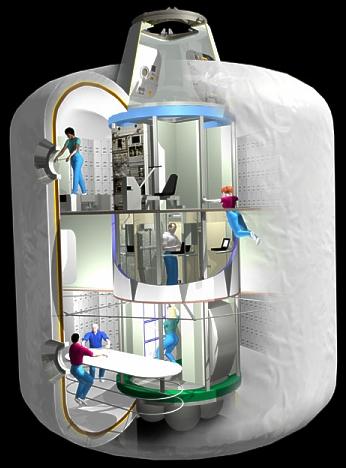Cray
06/24/04 06:32 PM
68.200.105.41
|
Code:
AeroTech 2 Vessel Technical Readout
* CUSTOM WEAPONS
.
Class/Model/Name: TransHab Life Boat
Tech: Inner Sphere / 3067
Vessel Type: Aerospace Fighter
Rules: Level 3, Standard design
Rules Set: AeroTech2
Mass: 10 tons
Length: 8 meters
Power Plant: 10 Fusion
Safe Thrust: 3
Maximum Thrust: 5
Armor Type: Standard
Armament:
1 Passenger Bay (7)*
2 Cargo Bay*
------------------------------------------------------------------------------
==Overview:==

Code:
.
The Transhab Lifeboat is a radical improvement over conventional life boats
found on countless dropships and jumpships today. Though heavier than normal,
most ships can spare the tonnage, and potential users heartily approve of the
Transhab's most notable feature:
.
It's inflateable.
.
The 3m diameter, 8m long cylinder fits in standard escape pod and lifeboat
docks. After ejection by conventional solid fueled rocket motors, the Transhab
typically engages another of its useful features, a 20-rated fusion engine, to
boost clear of the abandoned vehicle. When satisfactorily clear of danger, the
passengers or onboard computer will trigger the inflateable feature,
ballooning the Transhab from 3m in diameter (with about 10 cubic meters of
passenger space) to a thick cylinder 8m in diameter (with about 330 cubic
meters of passenger space, or about the equivalent of 2 typical bedrooms per
person).
.
==Capabilities:==
The Transhab is an advanced, rather expensive lifeboat (in comparison to the
standard lifeboat price of 5000CB). However, you get what you pay for.
.
With its fusion engine and 2 tons of hydrogen reaction mass, the Transhab has
significant in-space performance...at least, if one doesn't compare it to
other BT spacecraft. The 2 tons of reaction mass amount to 47000m/s delta-V,
enough to take the Transhab off Earth, land it on the moon, return without
aerobraking, and land. Indeed, the 2G's of non-overthrust engine performance
are enough to brake the Transhab to virtually nil velocity near most habitable
planets and let it land in a vertical fashion like a spheroid spacecraft.
.
While many are initially wary of the inflateable nature of the ship, the
30cm-thick hull is a mix of extremely strong ablative/flak fabrics and foams
that provide significant debris protection and will stop a standard medium
laser shot anywhere while retaining a pressure barrier.
.
Passenger facilities are generally minimal and lightweight, typical of a
lifeboat. The "cockpit" and "passenger bay" (designed for 7 people) cover the
basic life support, minimalist individual quarters, and more expansive (but
spartan) common areas. Two tons of cargo space are provided for supplies and
additional passenger-deployed equipment.
.
With the fusion engine, the Transhab is not as power-limited as most
lifeboats. Its outer hull is covered with sail material for secondary power,
and its batteries (derived from military energy weapon power packs) will last
a month of unregulated usage, but the fusion engine opens new vistas in
lifeboat design. Its emergency beacon can crank up to megawatt levels, for
example.
.
The Transhab has bow and stern docking ports. The stern port is the normal
boarding point, while the bow port includes a small airlock fit for 2-3
individuals. Using these ports, Transhab lifeboats can dock into columns and
pillars. Reportedly, next generation Transhabs will have side ports to allow
non-linear dockings, which become cumbersome for evacuations of large vessels.
(Imagine the entire crew of an abandoned warship with a single 1.5m diameter
passageway to move along their new, temporary home...)
.
Technically 10 tons, Transhabs have 10 cubic meters of cargo space in their
uninflated state (more, if initial passenger space is sacrificed). Transhabs
are readily available with up to 10 additional tons of interior equipment for
considerably more luxurious waits for rescue.
.
------------------------------------------------------------------------------
Class/Model/Name: TransHab Life Boat
Mass: 10 tons
Construction Options: Fractional Accounting
.
Equipment: Mass
Power Plant: 10 Fusion .50
Thrust: Safe Thrust: 3
Maximum Thrust: 5
Structural Integrity: 3 .00
Total Heat Sinks: 10 Single .00
Fuel: 2.00
Cockpit & Attitude Thrusters: 3.00
Armor Type: Standard (24 total armor pts) 1.50
Standard Scale Armor Pts
Location: L / R
Nose: 7
Left/Right Wings: 6/6
Aft: 5
.
Weapons and Equipment Loc SRV MRV LRV ERV Heat Mass
------------------------------------------------------------------------------
1 Passenger Bay (7)* Nose -- -- -- -- 0 1.00
1 Cargo Bay* Nose -- -- -- -- 0 1.00
1 Cargo Bay* Nose -- -- -- -- 0 1.00
------------------------------------------------------------------------------
TOTALS: Heat: 0 10.00
Tons Left: .00
.
Calculated Factors:
Total Cost: 616,525 C-Bills
Battle Value: 75
Cost per BV: 8,220.33
Weapon Value: 0 (Ratio = .00)
Damage Factors: SRV = 0; MRV = 0; LRV = 0; ERV = 0
BattleForce2: MP: 3, Armor/Structure: 1 / 0
Damage PB/M/L: -/-/-, Overheat: 0
Class: FL; Point Value: 1
.
Mike Miller, Materials Engineer
Disclaimer: Anything stated in this post is unofficial and non-canon unless directly quoted from a published book. Random internet musings of a BattleTech writer are not canon.
|